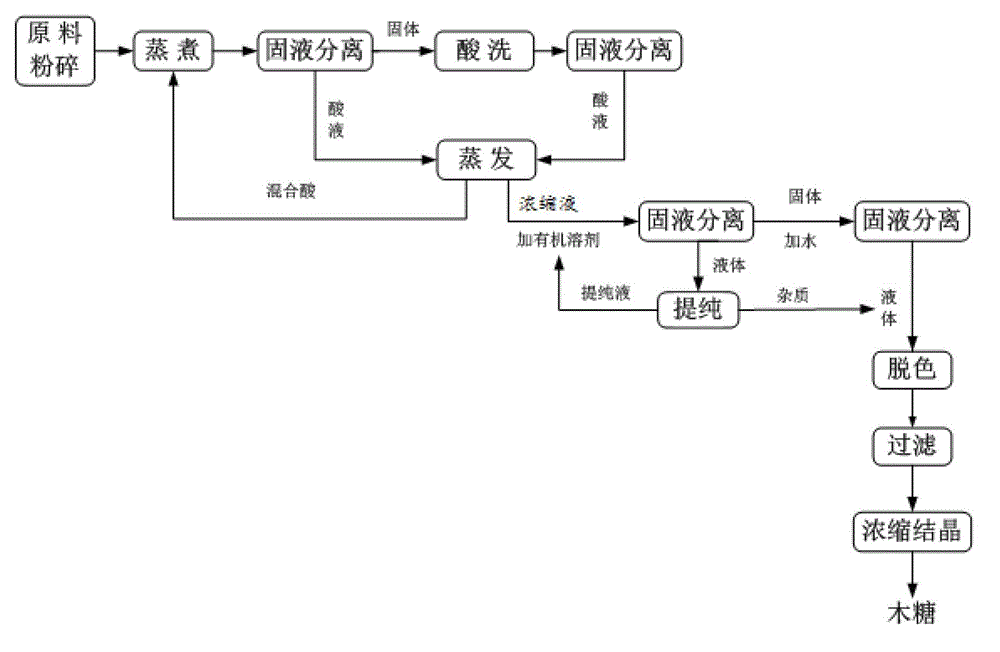A process for producing xylose from biomass raw materials
A biomass raw material, xylose technology, applied in the field of xylose production, can solve the problems of high acid-base energy consumption, complex xylose extraction process, etc., and achieve the effects of no acid-base consumption, avoiding processing difficulties, and avoiding esterification reactions.
- Summary
- Abstract
- Description
- Claims
- Application Information
AI Technical Summary
Problems solved by technology
Method used
Image
Examples
Embodiment 1
[0047] First, the reeds (hemicellulose content 22.8%) are crushed, washed with water to remove dust and crushed to a particle size of 0.5-20cm.
[0048] The comprehensive utilization process of biomass raw materials described in this embodiment comprises the following steps:
[0049] (1) After crushing the reed raw material for pretreatment, under the catalysis of hydrogen peroxide, use an organic acid solution with a total acid concentration of 60% to cook the treated raw material, control the reaction temperature at 105°C, and react for 100 minutes. The mass ratio is 1:5, and the obtained reaction liquid is subjected to solid-liquid separation for the first time, wherein the mass ratio of acetic acid and formic acid forming the organic acid liquid is 3:1, and the mass ratio of hydrogen peroxide accounts for 4% of raw material mass;
[0050] (2) Under the catalysis of hydrogen peroxide, the solid obtained from the first solid-liquid separation is added to a mixed acid soluti...
Embodiment 2
[0056] First, the wheat straw (hemicellulose content 31.4%) is crushed, washed with water to remove dust and crushed to a particle size of 0.5-20cm.
[0057] The comprehensive utilization process of biomass raw materials described in this embodiment comprises the following steps:
[0058] (1) After crushing the wheat straw raw material for pretreatment, under the catalysis of hydrogen peroxide, use an organic acid solution with a total acid concentration of 70% to cook the treated biomass raw material, control the reaction temperature at 115°C, and react 95min, the solid-liquid mass ratio was 1:9, and the reaction solution obtained was subjected to solid-liquid separation for the first time, wherein the mass ratio of acetic acid and formic acid forming the organic acid liquid was 12:1, and the mass ratio of hydrogen peroxide accounted for 3% of the biomass raw material quality;
[0059] (2) Under the catalysis of hydrogen peroxide, the solid obtained from the first solid-liqu...
Embodiment 3
[0065] In this embodiment, the biomass raw material is corn stalks. First, the corn stalks (with a hemicellulose content of 35.7%) are crushed, washed with water to remove dust and crushed to a particle size of 0.5-2 cm.
[0066] The comprehensive utilization process of biomass raw materials described in this embodiment comprises the following steps:
[0067] (1) After crushing and pretreating the biomass straw raw material, under the catalysis of hydrogen peroxide, use an organic acid solution with a total acid concentration of 90% to cook the processed raw material, control the reaction temperature at 130°C, and react for 20 minutes , the mass ratio of solid to liquid is 1:8, and the obtained reaction liquid is subjected to solid-liquid separation for the first time, wherein the mass ratio of acetic acid and formic acid forming the organic acid liquid is 10:1, and the mass of hydrogen peroxide accounts for the 5% of the quality of the above-mentioned biomass raw materials; ...
PUM
| Property | Measurement | Unit |
|---|---|---|
| particle diameter | aaaaa | aaaaa |
Abstract
Description
Claims
Application Information
 Login to View More
Login to View More - R&D
- Intellectual Property
- Life Sciences
- Materials
- Tech Scout
- Unparalleled Data Quality
- Higher Quality Content
- 60% Fewer Hallucinations
Browse by: Latest US Patents, China's latest patents, Technical Efficacy Thesaurus, Application Domain, Technology Topic, Popular Technical Reports.
© 2025 PatSnap. All rights reserved.Legal|Privacy policy|Modern Slavery Act Transparency Statement|Sitemap|About US| Contact US: help@patsnap.com

